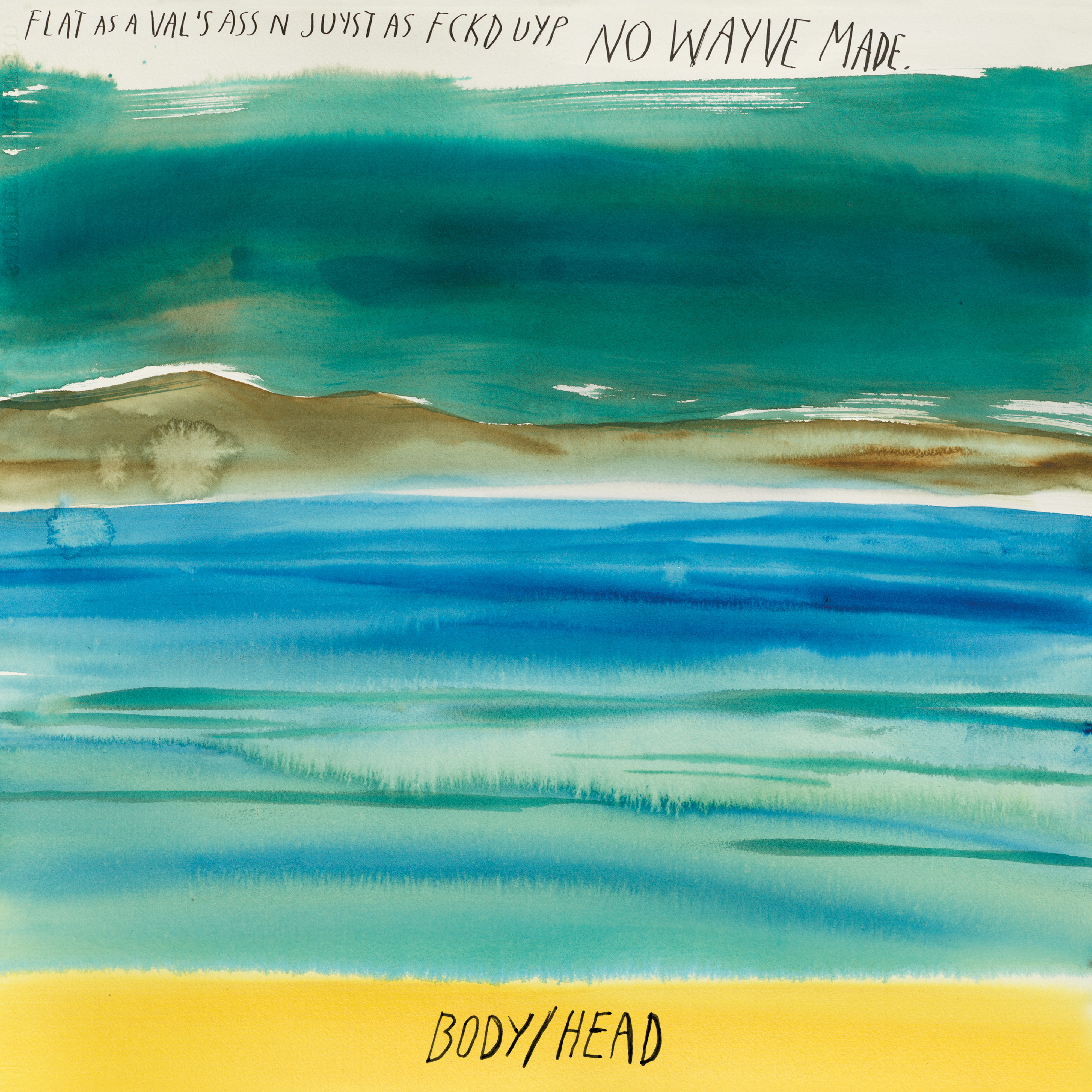No Waves, the title of the second album by Body/Head, presents a double entendre. One meaning is referential: no wave, a nod to the 1970s New York outsiders who refashioned the bashing masculinity of punk rock into something more amorphous and dissonant. Body/Head is the duo of Kim Gordon, formerly of Sonic Youth, and Bill Nace, a fellow guitarist and noise explorer. Gordon’s previous band emerged directly from the no wave movement, and Body/Head emerged from Sonic Youth.
The other meaning is literal: no waves, an uninterrupted smooth surface. The cool watercolor that adorns the album’s cover was painted by Raymond Pettibon, a wry and iconoclastic visual artist of the hardcore punk generation and a longtime friend of Gordon’s. If you were to take Pettibon’s scrawled and purposefully misspelled inscription above the painting as an advertisement for the music inside, you’d surmise that No Waves is “flat as a val’s ass n juyst as fckd uyp.” The album’s serene title and its goofily chauvinistic caption might both be read ironically. The objectification and attempted control of women’s bodies is one of the great themes of Gordon’s work, and the tides of the ocean provide an especially apt visual and kinetic metaphor for the undulating sheets of sound on her latest album with Nace.
By now, Body/Head’s backstory is fairly well known: Gordon and Nace got together following the dissolution of both Sonic Youth and Gordon’s marriage to her bandmate, Thurston Moore. The duo recorded their debut album, 2013’s Coming Apart, in a flurry of improvisation, crafting austere tableaux of feedback and desire with just Gordon’s voice and their guitars. They approached the album’s pieces like sculptors, working with a deliberately limited set of materials, their minimalist drones evoking the tumultuous inner spaces of the heart and the mind.

Also Read
All Noisy on the New York Front
No Waves was recorded during Body/Head’s set at the 2014 Big Ears Festival of experimental music in Knoxville, Tennessee, about six months after the release of Coming Apart. It announces itself as a live album right away. After a scene-setting open guitar chord, the first sounds you hear are the whoop of an excited attendee and the 60-cycle hum of an amp that’s out in the wild, away from the insulated confines of a studio. Two of the three long tracks that make up No Waves appeared in some form on previous Body/Head releases: “The Show Is Over” was the A-side of a 7-inch released in 2014, and “Abstract Actress” is ostensibly a medley of the two Coming Apart tracks from which it takes its name.
But rather than trying to replicate their off-the-cuff studio performances onstage, Gordon and Nace treat the songs as rough outlines for further improvisation, to be colored in as the musicians please. As such, these songs are familiar only in fleeting moments: the spectral harmonica that appears halfway through the nearly nine-minute “The Show Is Over,” the vocal mantra that closes the 23-minute “Abstract Actress.” The extended versions turn the songs around, away from the cloistered introspection of Body/Head’s debut, and toward the motion and wild patterns of nature.
Gordon and Nace bring a wide spectrum of percussive and harmonic sounds from their guitars, avoiding traditional playing techniques, piling up and slicing off layers of finely detailed texture. Despite its lack of drums and recognizable song structures, this is physical music, not at all ambient. Halfway through No Waves opener “Sugar Water,” one of the guitarists answers a swell of feedback with an abrupt chunk of low noise, just as Gordon arrives at a particularly hard syllable at the end of a vocal line. The climax arrives with such force that it might as well be accompanied by crash cymbals. I’ve never seen Body/Head perform live, but I have vivid memories of watching Nace perform in 2008 with Northampton Wools, his noise duo with Thurston Moore, attacking his strings with a screwdriver.
At the end of “The Show Is Over,” rushes of noise arrive like a flood, and Gordon’s filtered voice sounds like it is about to submerge. In moments like this, the music has a shifting rhythmic counterpoint that recalls not Steve Reich—the minimalist composer name-checked by so many experimental rock and electronic artists—so much as La Monte Young, his woolly predecessor. While Reich’s propulsive minimalism was informed by the urgent mechanical rhythms of 20th-century urban life, Young was less interested in strict rhythmic grids, drawing instead from the howling wind and buzzing power transformers of his rural Idaho upbringing.
Body/Head’s churning slurries of sound in these moments also bring to mind John Coltrane, whom both Gordon and Reich cite as a formative influence, and—if you’ll allow a flighty comparison—the cascading prose of James Baldwin. “He uses words as the sea uses waves, to flow and beat, advance and retreat, rise and take a bow in disappearing,” Langston Hughes wrote of the younger writer’s impassioned tumbles of clauses and commas in a 1958 essay. Swap out “words” for “guitars” in that sentence, and you aren’t far from the sound of No Waves, the winking contradiction of the album’s title notwithstanding.
But the album’s most haunting presence is a more familiar one for Sonic Youth fans. About two thirds of the way through “Abstract Actress,” the gripping performance that closes the album, Gordon begins singing the phrase “beat me out of me”—the refrain from “Aneurysm,” the immortal Nirvana single recorded just before the Nevermind sessions, originally released as the B-side to “Smells Like Teen Spirit.” At first, Gordon sounds like she has come upon the line in a flight of free association, but after a few repetitions, she digs further into the “Aneurysm” lyrics: “Come on over, and do the twist,” “I love her so much, it makes me sick.”
The effect is hair-raising. “Aneurysm” stands as the first moment in the Nirvana catalog when Kurt Cobain is visible as the conflicted and conquering rock star he would later become. Invoking these naive lines at a pivotal juncture in her own performance, Gordon seems to be reaching toward Cobain—a friend with whom she had a “big sisterly, almost maternal” relationship, she wrote in her 2015 memoir, Girl in a Band—at a similarly pivotal time in his life, before the pleasures and pressures of fame swept him up.
Not long before Nirvana recorded “Aneurysm,” Sonic Youth released the song “Tunic,” the lyrics of which Gordon wrote from the perspective of the late soft-rock singer Karen Carpenter, who died in 1983 from complications related to anorexia nervosa. Taking Cobain’s words as her own on “Abstract Actress,” Gordon channels both her own inhabitation of Carpenter on “Tunic” and the yearning of the song’s Carpenter character, who communes with her rock’n’roll idols in heaven: “Hello Janis, hello Dennis, Elvis, and all my brand new friends / I’m so glad you’re here with me.”
We hear another snatch of the 60-cycle hum that opens the record as “Abstract Actress” winds down—a sound not unlike that of La Monte Young’s power transformers, occurring when a guitar setup isn’t properly grounded or is experiencing outside electrical interference. Nace and Gordon take something that most guitarists think of as an annoyance and deploy it as a musical element, processing the hum with a delay effect so that it becomes a throbbing bass note. Gordon comes back to earth, chanting the lyrics to “Abstract,” the first song on Coming Apart. Soon, to quote another song title, the show is over. “Thanks for coming to see us,” she tells the audience. “Have a great night.”




